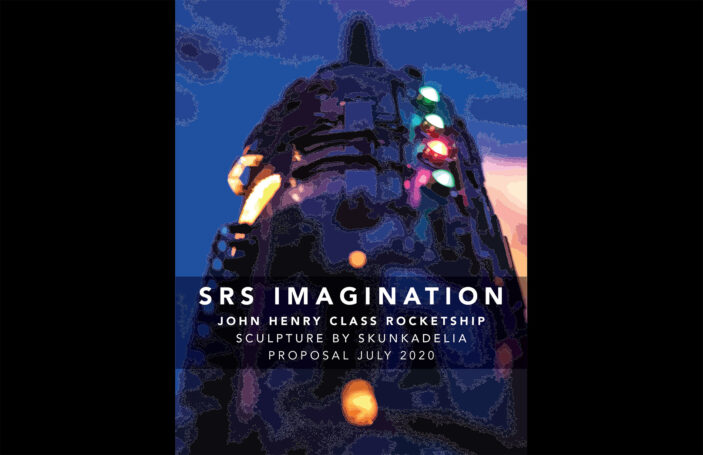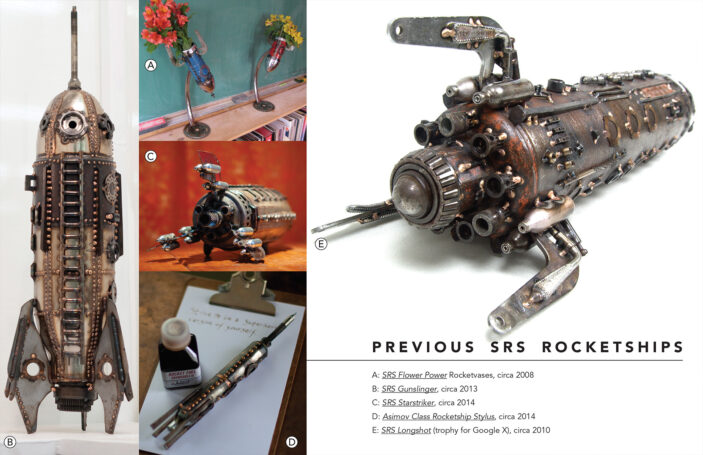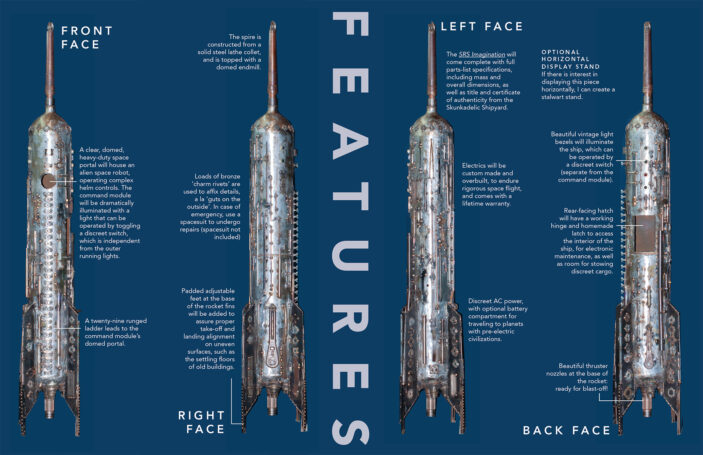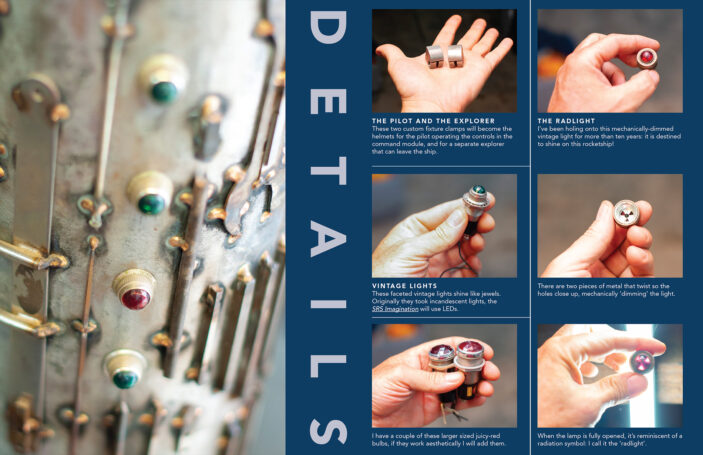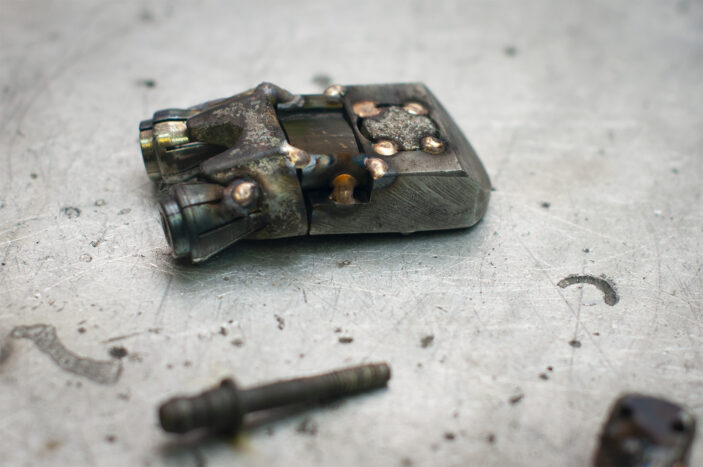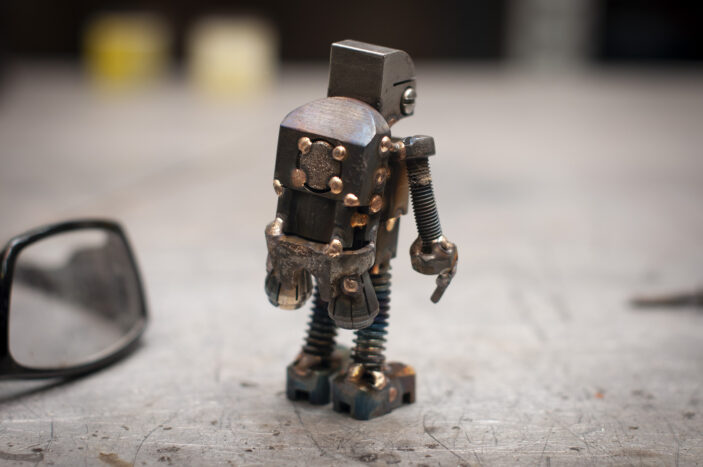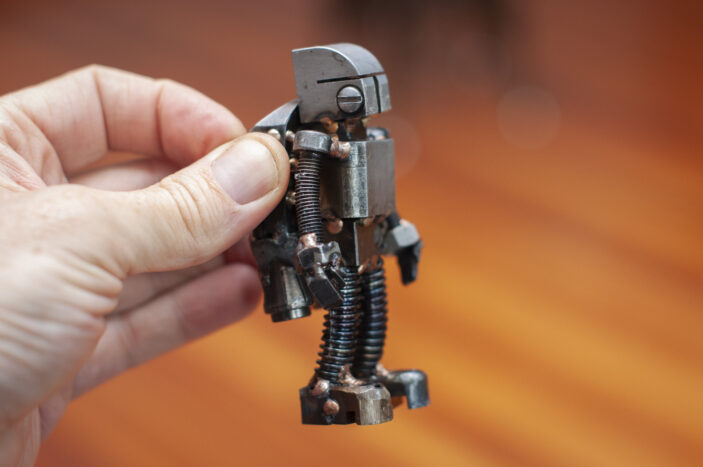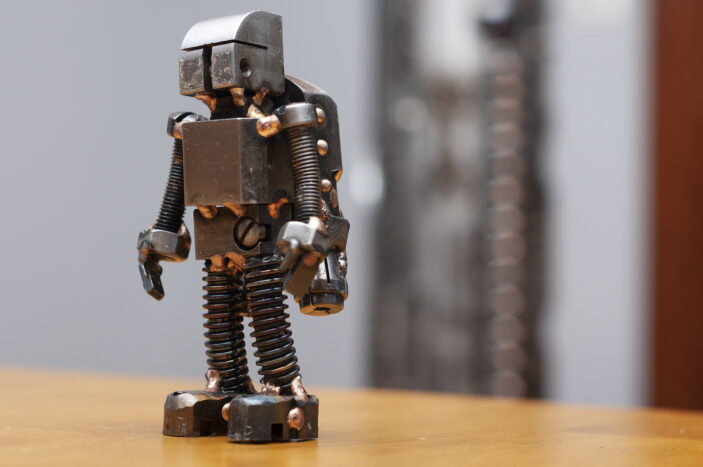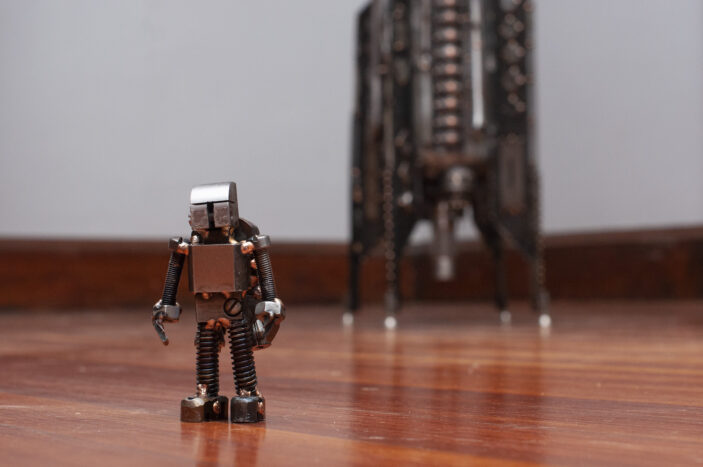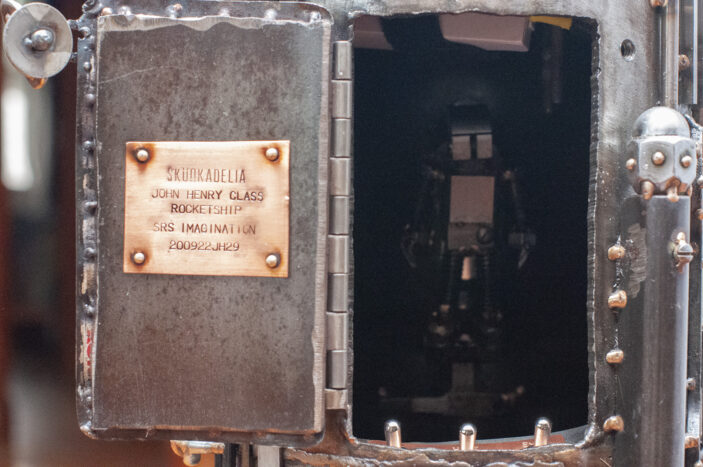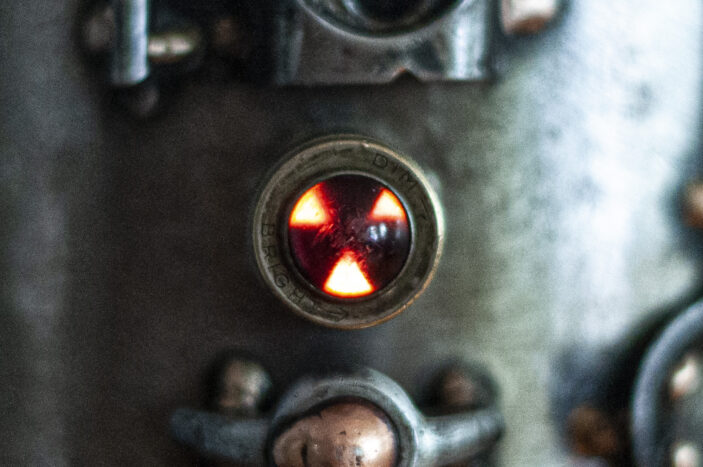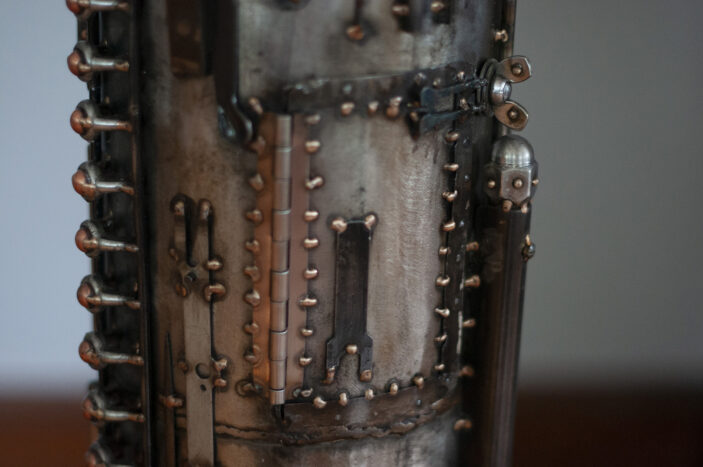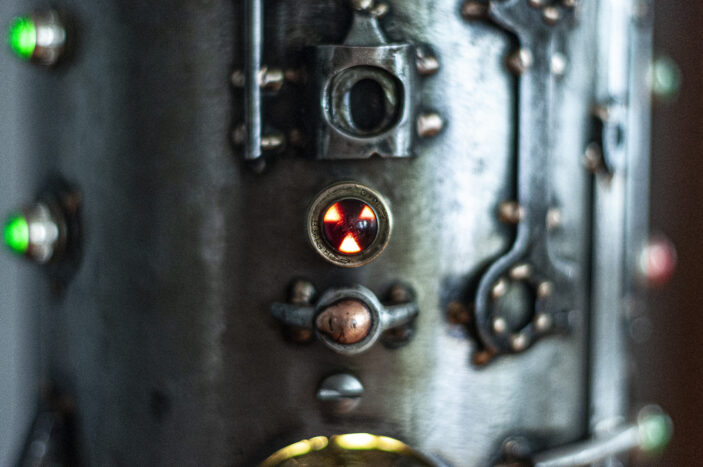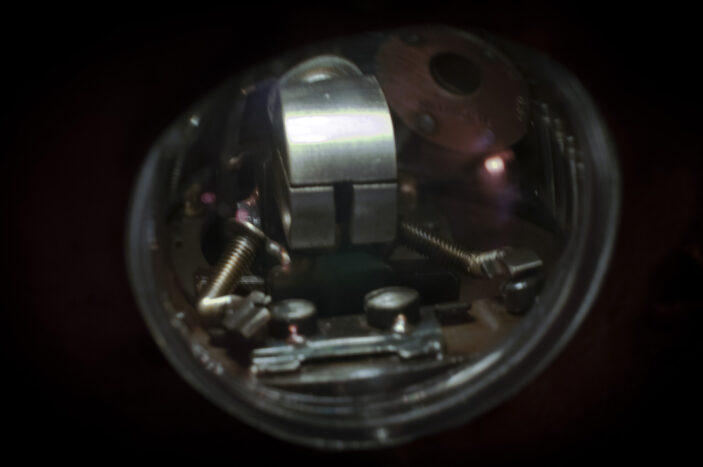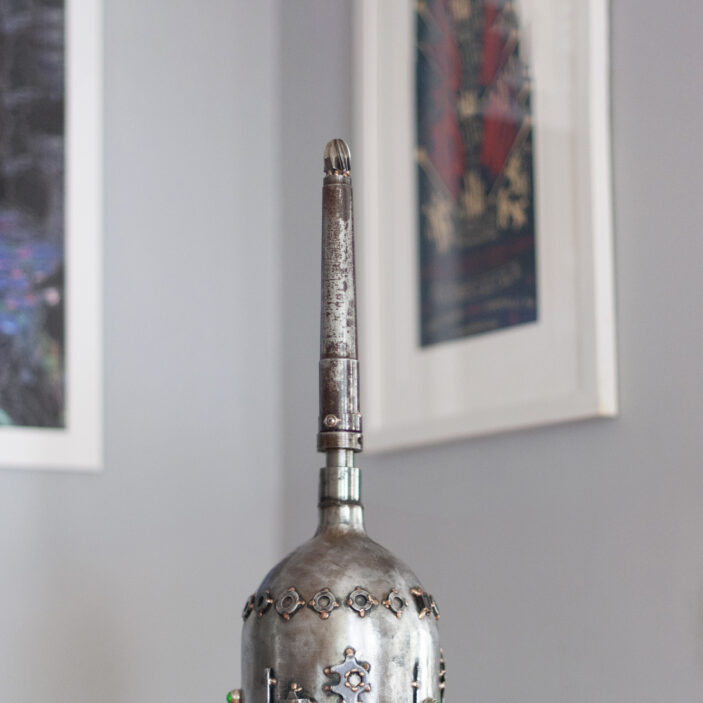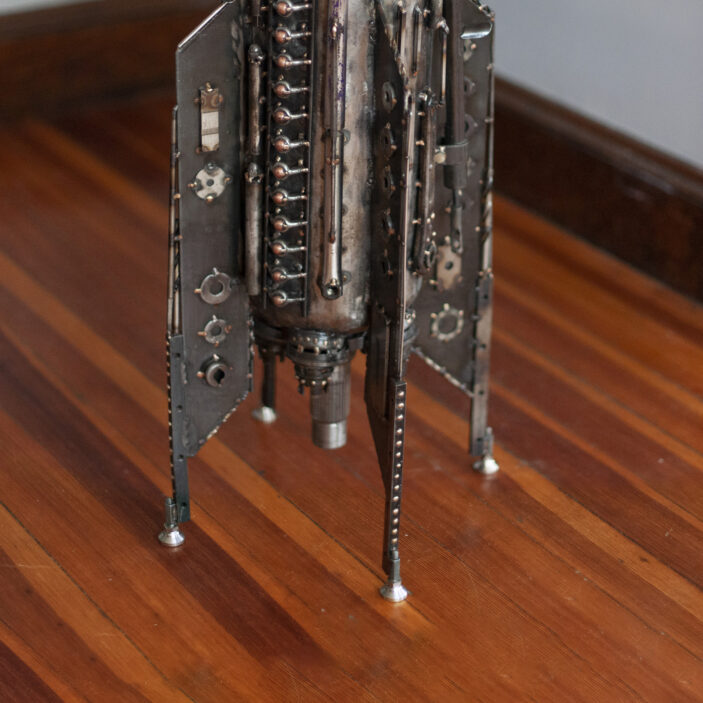This is the sixth and final chapter in the odyssey of constructing the SRS Imagination, a John-Henry class rocketship. Be sure to read chapters one, two, three, four and five to know the whole scoop, up to this point.
The Proposal
Before I finish the story, I’d like to share the proposal that I put together for my client. Complex projects such as this one need thoughtful planning, and creating a proposal helps solidify that plan. I have a good deal of experience with page layout, photography, illustration, and design, so I try and use those skills to have a lot of fun with the proposal. While art of this magnitude is a serious endeavor, I hope to never lose sight of the fun and the joy of it. The proposal was made after the rocket was started, so I had the rare pleasure of being able to use some images of the actual piece in the PDF.
As with all the images in these chapters, clicking on the image will open a larger image, if you care to take a closer look.
As I re-read the proposal I put together, I’m happy to say that we did not stray far from the original vision. We opted out of the horizontal mounting stand, and I decided not to use the larger lights, as I thought the the sense of scale was wrong for the size of the rocket. One client-requested feature that was not in the proposal was to have the lights controllable through the Internet of Things, which was successfully implemented in chapter five.
There’s one more page in the proposal about price and delivery details: for obvious reasons, I’ve left it out of this story.
The Explorer
My proposal mentions an explorer – a companion to the pilot. This was an exciting part of the project, and I wanted to have this little guy shine. The idea is to have him able to travel away from the ship, to go on adventures of his own, then report back home to the rocket. Since I want the Imagination and its crew to survive as a unit for hundreds of years, having an element separate from the rocket leaves the possibility of it getting lost. This is exciting to me: there is an inherent danger to exploration and space travel, and I like the idea of having this aspect of risk.
While I’m fairly well-versed in creating robots, I wanted this figure to feel like a human explorer. At this scale it was particularly challenging to find just the right parts to give the feeling of a real astronaut. After a couple of weeks of keeping an eye out for parts, along with short moments of actively seeking elements, I had most of the assemblage looking like a person, but it still gave me a ‘Frankenstein’s monster’ vibe. I realized that vibe was coming from his blocky feet.
These are the feet that I wound up using: a couple of machined steel blocks welded together for each foot, with the toes ground down so the edges became rounded. They now look like moon-boots, and less like robot-feet.
The jetpack of the explorer was a lucky combination of a few parts that happened to be the right shapes and proportions. The two tiny collets fit very nicely into the cast pipe-clamp part, as if they were made for each other. They were most certainly not made for each other, that’s for sure! The foreground of the above photo shows the inner shaft of a spark plug, which I contemplated using for an antenna, but decided against it as it took away from the humanoid shape. I wanted the explorer to be instantly recognizable from a distance.
I can’t get enough when it comes to the colors that come out of the steel and bronze from welding.
Here’s the completed explorer with the jetpack engaged. Fwoooosh!
Sure looks like he’s got a lot on his mind, doesn’t he? I can’t explain why I read so much into this little figure, but I’m glad he emotes as much as he does.
It’ll be fun for the folks who play with this rocket in the future to set up photos, and even play with the parts. I do hope folks who hang with this rocket have some playtime fun.
The explorer lives in the Imagination, safely secured by a neodymium magnet.
Presenting the SRS Imagination!
At long last, the rocket is complete! I’ll shut up now and let the photos speak for themselves.
Final Specifications of the SRS Imagination
Dimensions: 65 x 12.5 x 12.5″
Gross Mass: 85.8 lbs (including payload and crew)
Parts List
Exterior
Two steel SCUBA tanks, four pieces of plate steel rescued from a metal scrap bin, ball end mill, large lathe collet shaft, thirty wing nuts, one wing bolt, five bicycle wrench tools, thirty copper rivets, stainless steel bicycle rack part, fifteen high carbon steel blocks, door knob axle, sixty-one washers, music box movement, two wood screws, five machine screws, bolt, fifteen drill bits, three files, nineteen rods, nineteen go no-go gauges, two pins, tent stake, small diameter chromoly tubing, hinge, two hack saw blades, two flooring nails, four end mills, five acorn nuts, slider rivet tool, two plates, steel tube, six typewriter parts, two unknown machine parts, one furniture assembly wrench, two handles, two bicycle crank arms, two socket wrench handles, bicycle spoke, bolt, four coupling nuts, four stainless adjustable feet, two hand punches, bicycle seat clamp part, seven vintage lamps, one vintage mechanically dimmable lamp, block, automobile brake caliper part, eight three-speed internal hub bicycle parts, four bottom bracket cups, large machine spline, polycarbonate dome, copper sheet, bronze
Interior
Vintage coffee can, copper plate, three toggle switches, two go no-go gauges, machine part, brass machine screw, neodymium magnet, industrial sewing machine foot, washer, three unknown machine parts, five bicycle quick-release skewers, eighteen machine screws, vacuum cleaner cord, electrical parts, battery harness, rod, sixteen LEDs, polycarbonate sheet, steel valve, rod plate, four chain link plates, steel ring, two bicycle coaster brake hub flanges, eighteen tiny machine screws and nuts, spark plug gauge, hair clipper blade, two washers, three nuts, three machine screws, two round punch blanks, plate steel
Pilot
High carbon steel block, custom made fixture part, four machine screws, nut, two bicycle three-speed internal hub pawls
Explorer
Four blocks, custom made fixture part, four machine screws, acme threaded rod, square nut, two nuts, unknown bicycle internal hub part, specialized clamp part, rod clamp part, two small collets, round blank, two bicycle three-speed internal hub pawls
The Secret Bonus Surprise
I wanted to add a surprise feature to the Imagination that the client could discover. This wasn’t in the proposal. I had a music box movement sitting in a drawer labelled ‘favorites’, and while I was planning on putting it inside the body of an Astrobot, I realized that it was the perfect time to use it. The song is all too fitting for an adorable rocketship such as this one.
I was worried that the music wouldn’t be loud enough, but the steel chamber of the rocketship body seems to amplify the music to just the right levels. It took me a whole afternoon to design and create the inner mount for the movement; I think it was time well spent. I’m able to share this will you, the reader, now that the client has discovered it on his own.
The End of the Construction is the Beginning of the Adventures
I was also fortunate enough to have a couple of weeks between completion and delivery. I kept the Imagination lit by the batteries the whole time and it never ran out of power, as I predicted: it was still nice to see it happen in the real world. We got to calling it ‘the world’s greatest night light’, because it is.
If you have had the stamina to read this entire series, you probably have a good understanding of the joy I felt creating this epic work of art. In the past I have considered myself very ‘results driven’, meaning that I got my endorphins once I could say I was finished with a piece. For this project, I took great pleasure in the process, losing myself in the work, slowing down to savor doing the best I could along the way. Like any project that involves unexplored territory, there’s an opportunity to grow. While I was thrilled to complete the SRS Imagination, I took my sweet time traveling on the road to completion. With the construction complete, I now look forward to making more work of this scale and complexity.
Thanks for reading.
–Skunk
Related Posts
Constructing a John-Henry Class Rocketship: Stage One
Constructing a John-Henry Class Rocketship: Stage Two
Constructing a John-Henry Class Rocketship: Stage Three
